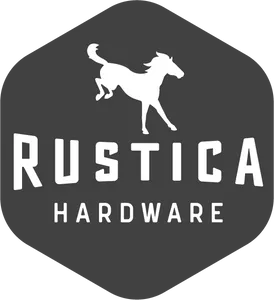9 Steps to Installing Barn Door Rollers
- Measure Door Size and Track Length
- Gather Needed Tools
- Locate Studs
- Pre-Drill Holes
- Install Header and Barn Door Track
- Install Stoppers
- Attach Barn Door Rollers
- Hang the Sliding Barn Door to the Track
- Install Anti-Jump Guides and Blocks
1. Measure Door Size and Track Length
The first step in installing a barn door kit is to make sure you have the correct sized door. There are two main measurements you need to take before installing a sliding barn door: the door opening and the length of the track that you need.Using a measuring tape, measure the door opening. You want to make sure that you do not include the trim in your measurements at this step. Therefore, you’ll want to measure from the inside edges of the trim. Measure from left to right and then top to bottom. This will give you the measurements of the door opening. At this point, measure the width of any trim, and add that amount twice to your door opening width, and once to the height. This is the opening you are aiming to cover.
Then, you’ll want to make sure your door slab is bigger than the door opening. You want a slight overlap of 2 inches with barn doors to make sure the entire opening is covered. It’s also important to take note of the thickness of your door.
You’ll also want to measure the space between the height of the door and the ceiling. Some rolling hardware requires a certain amount of space to fit and look good. Fortunately, if you are short on space, there are low clearance hardware options available. If you are ever unsure, feel free to give us a call and we can clarify any measuring questions.
When it comes to measuring for your barn door track, you’ll want a track at least twice the width of your door opening. However, if your door opening does not have any trim, you’ll want to subtract 2 inches from the total track length so that when the door opens, it lies flush with the edge of the opening. For example, if your door opening is 38 inches, including trim, then you’ll order a track that is 76 inches. But, if your opening doesn’t have trim, then you will want to order a track that is 74 inches.
It is recommended to not just calculate this measurement, but to physically measure to make sure you have enough space for your door to roll open, and that there are no obstructions like light switches or outlets.
Take a moment to measure the depth of any door trim. If it's more than an inch deep, you will need to get spacer hardware that will extend the barn door further out from the wall so the door can roll easily over the trim. The other option is to install a header that will give you the needed depth.
Consider Getting a Header
A header is optional but highly recommended. A header, also called a mounting board, is a piece of wood that you will attach to your wall and then you will attach the rolling track to the header. This can make the door sturdier, especially if the sliding barn door is heavy or extra wide. Another benefit is if the studs in your wall are irregular, and you want your barn door track hardware to look more symmetrical. By attaching a header first, you anchor it to the studs, and then you can symmetrically attach the track to the header and still achieve stability and strength.
Additionally, using a header can add an extra element to the overall look of your sliding barn door. Headers are customizable. You can order it in a variety of colors and finishes, or you can get it unfinished and then paint or stain it yourself to match your decor. It is recommended that your header be 4-inches longer than your track, extending 2-inches past the track on both ends.
Where to Obtain Barn Door Hardware Kits
The popularity of barn doors in interior design means that you can easily find barn door hardware. You can purchase from your local big box home improvement store, or you can work with a company like Rustica that offers high-quality barn door rollers in many styles and finishes to give your finished project just the look you want.
A barn door hardware kit will include the sliding barn door track and rollers that are needed to install your barn door. The size of the barn door kit that you need depends on your door opening and track measurements. Barn door kits come in many sizes, with door widths often ranging from 24-inches to 36-inches. To make sure you get the correct size barn door kit, you’ll want to take all measurements before placing your order or picking one up.
2. Gather Needed Tools
Once you’ve ordered your sliding door hardware and it’s arrived at your location, you’ll need to gather the tools needed to install the door. Some of the tools that you’ll need to install your sliding barn door include:- Measuring Tape
- Wrench
- Ladder
- Wood screws
- Drill
- Level
- Stud Finder
- Pencil
- Ratchet
Double-Check Rollers and Track
While you have already measured your door opening and your space for the track length before ordering, it is important to measure your sliding barn door hardware once you receive it. This helps ensure that you have the appropriate size. There’s nothing worse than starting a project only to find out that you have the wrong size barn door rail and rollers. This extra step also allows you to confirm that the size is appropriate for your space before you start drilling and installing.
3. Locate Studs
Whether you are hanging the track directly on the wall or using a header, you must locate the studs in your wall. A barn door’s weight cannot be held up simply by drywall. Failing to find the studs to hang your rolling door hardware can damage your wall, your door, and your sliding barn door hardware. The easiest way to locate studs is to use a stud finder.Using a stud finder is relatively easy. All you need to do is turn the unit on and slide it along the wall until it lights up to indicate a stud. Then you mark it with a pencil. You will use the studs to hang either the track or the header on which you will hang the rolling door hardware.
4. Pre-Drill Holes
Before you hang your sliding door hardware, it is recommended that you pre-drill holes. This will save you both time and effort when you start to hang the hardware. This is true whether you are hanging your track directly on the wall or a header. If you are using a header, it is helpful to pre-drill holes on both the header and the track.Pre-drilling holes simply means measuring your track and using a drill to make holes where the track or the header will attach to the studs you located in the previous step. This makes it easier to place the screws and attach the sliding barn door hardware to the wall.
5. Install Header and Barn Door Track
The next step is to install the header (if you’ve opted to get one) and the barn door track.When installing the header always make sure to use a level. This will help ensure that the header is installed straight. Screw the header into the wall studs that you marked during the last step.
When mounting your sliding barn door track on the header, the holes for your track should measure 3-inches from each end of your header, 3-inches from the top and 2-inches from the bottom of the header. This process is the same whether you are using regular barn door track and rollers, heavy-duty barn door rollers, or small barn door rollers. Use a level to ensure
If you are attaching the barn door track and rollers directly to the wall, you’ll want to screw your track into the studs located earlier in the process.
Every DIY barn door hardware kit will come with specific installation instructions regarding measurements for spacing. You’ll want to make sure you consult with these instructions to ensure that your placement is correct so that your door opens and closes smoothly. Again, you’ll want to use a level when you hang your sliding barn door track. If your track is not hung straight, your barn door is likely to have trouble opening and closing.
If you ordered spacers to accommodate deep trim, this is also a good time to install them per the accompanying instructions.
6. Install Stoppers
Every barn door hardware kit should come with door stoppers. This essential piece of barn door rollers hardware keeps the sliding barn door rollers from reaching the edge of its track. In other words, this small piece encased in rubber that keeps the door from rolling right off the end of the track. This door stopper helps protect your door from getting damaged, as well as yourself and other things in your space. Standard stoppers are vertical because most hangers themselves are vertical. However, if you have a hanger that doesn’t have a flat vertical edge, then you’ll want to get a round stop.How to Slow Down Barn Door Rollers
While the door rolling off the end of the track is a concern, the door slamming opened or closed is another major concern that homeowners have when installing barn door hardware. This can be especially problematic depending upon the door since door weight affects how quickly the barn door rollers move along the track. This can be resolved by installing a soft close system. The soft-close system attaches directly to the track and prevents the door from slamming, which can be especially helpful with sliding double barn doors. Simply request a soft-close system when ordering your hardware kit.
7. Attach Barn Door Rollers
Once the track is ready, it’s time to attach the barn door rollers that come with your hardware kit. Barn door rollers are essentially the wheels that move the barn door back and forth with the help of a hanger. The good thing with barn doors is that you can easily change the way they look by changing the barn door rollers only. The process is the same whether you are installing a barn door for the first time or if you are installing barn door replacement rollers. You attach barn door rollers to the door by first attaching the hanger and then the wheel. Each style of hanger comes with its own installation instructions, so be sure to check your hardware kit to ensure your hangers are installed on the door properly.8. Hang the Sliding Barn Door to the Track
While this might be the shortest step in the process, barn doors can be heavy and awkward, so having an extra set of hands is always helpful to make sure you don’t get hurt and that your door is hung properly. Lifting evenly, set the groove in the center of the wheel onto the track at a slight angle to ensure the track settles properly. Slowly lower the door, and then use a level to ensure the door is hanging straight.9. Install Anti-Jump Guides and Blocks
After the rollers are attached, you’ll want to install another important piece of sliding barn door hardware: anti-jump guides and blocks. This barn door hardware plays an important role in keeping your barn door on the track. Anti-jump guides are installed on the door side and adjusted to between ⅛” to 1/16” from the bottom edge of the rail.In addition to anti-jump guides and blocks, it is also important to install a floor guide. This will help keep your barn door from coming off track or banging against the wall. You can get several different styles of floor guides, including wall-mounted or floor mounted. You can also get barn door guide rollers that use a wheel to help guide the door along its path rather than just a metal bracket. The choice depends on the style of door you choose and your personal preference.
How to Maintain Barn Door Rollers
Now you’ve installed your sliding barn door hardware and you can start enjoying it. The good news is that interior barn door rollers are relatively low maintenance. This is why you’ll often see antique barn door rollers still working perfectly. While barn door rollers are low maintenance, there are still things that should be done to ensure they continue functioning like new.Wipe Down Hardware and Track Routinely
Dust and debris are the number one enemy to barn door rollers. Therefore, you want to make sure that you wipe down your sliding barn door rollers and track routinely. This can be done by simply including your track in your regular dusting schedule. You just want to make sure that the track stays free from dust so that the rollers continue sliding smoothly.
Keeping the track free from debris is especially important when dealing with exterior barn door rollers. This is because dust, dirt, leaves, rust, etc. can easily accumulate on the track. This can cause the wheels to have difficulty sliding back and forth along the track. However, if you keep the track clean you can extend the life of your barn door hardware.
Keep Barn Door Hardware Clean
In addition to keeping the track free from dust and debris, it’s important to keep your barn door hardware clean. This is true whether you have vintage barn door rollers or new barn door rollers. You want to consider the material and finish of your barn door hardware before you begin cleaning. Most often you can simply use an all-purpose cleaner or if you want to prevent any wear on your finish just use a soft cloth and distilled white vinegar.
You can also use olive oil to clean your barn door hardware. It doesn’t leave visible streaks and helps keep your hardware in good condition. Olive oil can be used with all kinds of finishes. When it comes to stainless steel, just remember that any cleaner that is safe for glass is typically safe to use on stainless steel including a solution of water and vinegar. Always be sure to use a soft cloth to make sure you don’t scratch your metal hardware.
How To Lubricate Barn Door Rollers
If you want to make sure your door continues to move smoothly, you need to keep your barn door rollers and track lubricated. You can lubricate rollers and tracks in several ways. One way is to use a lubricant spray for easy application. You can also choose to use a clear grease with the rollers and track, which allows you to apply with more precision and avoid over-spray. The third option for lubricating barn door rollers and tracks is to run a piece of beeswax by hand along the length of the track. Always be sure to check all of your bolts, nuts, and screws when lubricating your rollers and track to make sure everything remains snug. Keeping barn door rollers and tracks lubricated can keep even old barn door rollers moving like new.







